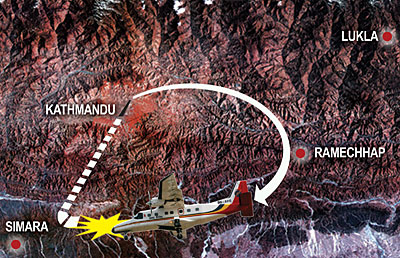 |
0700: Word came that Lukla had good visibility for the first time in more than a week. Domestic airlines scrambled to get their planes in the air. There was a huge backlog of passengers and cargo at both Kathmandu and Lukla as the Khumbu geared up for the autumn trekking season.
0704: Although Kathmandu had heavy rain and poor visibility, Hotel Echo got clearance. Capt Lucky Shah, a veteran pilot with nearly 30 years of flying experience in Nepal and India, and co-pilot Sophia Singh, who had logged nearly 920 hours on Dorniers, were in the cockpit. Hotel Echo was first off the domestic apron with a Buddha Air Beech 1900D taxiing out for a Mt Everest sightseeing flight.
0710: After takeoff, the plane cancelled its standard instrument 'Igris-1 Alpha' departure, involving a climbing circle overhead, then headed north east.
0718: Hotel Echo was 35 miles out, approaching Ramechhap, when it decided to turn back because of reports that clouds were closing in on Lukla. It is not known whether the pilot had already detected problems in the cockpit.
0720: Hotel Echo acknowledged instructions to maintain an altitude of 12,000 ft and follow a 20-mile arc to the south to make an instrument approach to Kathmandu. A few minutes later, the captain indicated generator malfunction but did not declare an emergency.
0722: Capt Lucky was in touch with the crew of another Lukla-bound Agni crew on the ground in Kathmandu (9N-AIE), and said he was trying to switch to the backup generator, but was having difficulty. He then said he was trying to 'recycle' the battery pack. Generators supply power to cockpit instruments, and without it most avionics shut down and the pilot is flying without direction or distance-measuring equipment.
0725: Capt Lucky said he could see the terrain and would shoot for a 'visual approach' to Kathmandu. The alternate airport at Simara was closed due to bad weather. That was the last contact from Hotel Echo, and the plane dropped off the radar. 
0736: At the plane's estimated time of arrival in Kathmandu, the radio remained quiet and there was no sign of the plane.
The crash crater at Shikharpur at 1,700ft altitude is 10m wide and 5m deep. It is clear the plane hit the ground at a steep, if not vertical, angle. The impact probably happened around 0726, a couple of minutes after the last communication and just two miles short of the right turn Capt Lucky was supposed to make to intercept the approach to runway 02 in Kathmandu.
Why did the plane spin out of control? Was the crew disoriented in whiteout conditions over rugged terrain? Did the engine flameout due to heavy rain? Was the pilot trying to break through cloud to remain visual and couldn't pull out? Was there fuel adulteration?
Only the contents of the black box can now tell us more, and perhaps offer lessons for the future about aircraft maintenance, rules for bad weather flight, and weak regulatory oversight.
READ ALSO:
"I don't want any more Sarahs to die",
Crackdown riles ISPs
Trafficking labour, JB PUN MAGAR and BABURAM BISWOKARMA


